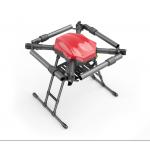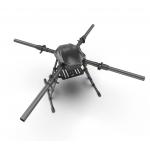Product Background
The innovation in the field of materials has laid the foundation
for this. New types of high-strength and low-density materials are
constantly emerging and being widely applied. Carbon fiber
composite materials, with their excellent specific strength and
specific modulus, have become the ideal choice for frame
manufacturing. They not only significantly reduce the weight of the
frame itself but also can withstand huge stress and loads, ensuring
the safety and stability of the unmanned aircraft when carrying
15kg of cargo during flight. For example, the frame made by
multi-layer carbon fiber weaving process can reduce the weight by
approximately 30% compared to traditional aluminum alloy frames,
while the tensile strength can increase by more than 50%.
In terms of structural design, advanced technologies such as
computer-aided design (CAD), computer-aided engineering (CAE), and
finite element analysis (FEA) have enabled engineers to deeply
optimize the frame structure. By precisely simulating the complex
stresses endured by the unmanned aircraft during flight, more
reasonable frame layouts can be designed. The common multi-axis
layout has been meticulously improved, making the rotor lift
distribution more uniform, effectively enhancing the flight
stability of the unmanned aircraft under heavy loads. At the same
time, structural reinforcement is carried out on key parts such as
the arms and central frame, improving the overall rigidity and
torsional resistance of the frame, significantly reducing the
impact of flight vibrations on the cargo, and ensuring a smooth and
stable transportation process.
The upgrade of the power system is also crucial. High-power density
brushless motors are continuously being improved, paired with
intelligent and efficient electronic speed controllers, which can
adjust the power output in real time and precisely according to the
flight status. Facing different flight environments and load
conditions, the motor can respond quickly, ensuring stable flight
of the unmanned aircraft. At the same time, battery technology has
made significant progress, with the use of high-energy-density
lithium polymer batteries, providing a persistent and stable power
guarantee for 15kg payload flights, significantly extending the
flight range of the unmanned aircraft and enabling it to undertake
longer-distance transportation tasks.
The demand for transformation in the logistics and distribution
sector: The rapid development of the e-commerce industry has
presented unprecedented challenges to logistics and distribution,
especially the "last mile" delivery problem that urgently needs to
be solved. The 15kg frame of the transportation drone can flexibly
navigate through the skyscrapers of the city, skillfully avoiding
congested road traffic, and achieve rapid and precise delivery of
goods. Its 15kg load capacity precisely meets the transportation
needs of numerous small and medium-sized items, such as fresh food,
medicines, small electronic products, and document materials, and
can efficiently deliver them to consumers. For example, the 15kg
drone used by JD Logistics has piloted delivery services in some
cities, significantly reducing the delivery time from several hours
to less than half an hour, greatly improving logistics efficiency
and customer satisfaction.
The efficient operation requirements for agricultural
modernization: In the agricultural production process, pest control
operations and sowing operations often consume a lot of manpower
and time, and have low efficiency. The 15kg frame transportation
drone can carry sufficient pesticides, seeds or fertilizers and
conduct large-scale low-altitude operations above the farmland.
Compared with manual or traditional agricultural machinery, the
drone operates faster, has a wider coverage, and can ensure
uniformity and accuracy of the operation, effectively reducing the
waste of pesticides and seeds, and significantly increasing the
yield and quality of crops. Taking large-scale wheat planting areas
as an example, using a 15kg load-bearing drone for pesticide
spraying, the daily operation area can reach several hundred acres,
which is tens of times more efficient than manual spraying,
injecting strong impetus into the development of agricultural
modernization.
The urgent demand for emergency rescue: When facing natural
disasters or emergencies such as earthquakes, floods, and fires,
roads are usually severely damaged, and traditional transportation
methods are difficult to quickly reach the affected areas,
resulting in the inability to deliver rescue supplies in time. The
15kg frame transportation drone can respond quickly, carrying key
rescue supplies such as food, medicine, drinking water, and first
aid equipment, crossing complex terrains and adverse weather
conditions, and precisely delivering them to the hands of the
affected people. Its flexible flight characteristics enable it to
freely navigate through narrow spaces and ruins, securing precious
time for the rescue operation and becoming a key force in ensuring
the safety of the lives of the affected people. In a certain
earthquake rescue operation, the 15kg load-bearing drone
successfully delivered urgently needed food and drinking water to
the trapped people in the mountainous area, solving an immediate
crisis, fully demonstrating its important role in the field of
emergency rescue.
The fierce competition among drone manufacturers: As the drone
market continues to expand, more and more enterprises are entering
the field of drone manufacturing, making the market competition
increasingly intense. To stand out in the competition, each
manufacturer is increasing their investment in the research and
development of 15kg drone racks for transportation, striving to
achieve breakthroughs in performance, reliability, and cost
control. They continuously optimize the design of the racks, adopt
new materials and advanced manufacturing processes to improve
product quality; at the same time, through technological
innovation, enhance the intelligence level of drones, such as
adding autonomous obstacle avoidance, intelligent return to base,
and path planning functions, to meet the increasingly diverse needs
of customers. This intense competition is driving the 15kg rack
transportation drone technology to continuously iterate and
upgrade, with product performance becoming increasingly
perfect.
Competition with traditional transportation methods: Transporting
15kg drone racks as an emerging transportation method requires
competing for market share with traditional transportation methods
such as cars, trains, and airplanes. Although drones currently have
certain gaps in load capacity and range compared to traditional
transportation methods, in specific scenarios such as
short-distance deliveries within cities and transportation of
supplies to remote areas, their flexibility and efficiency
advantages are fully demonstrated. To further enhance
competitiveness, drone manufacturers are committed to increasing
the load capacity of 15kg drone racks, extending their range of
operation, reducing operating costs, and strengthening cooperation
with logistics companies and e-commerce platforms, exploring more
feasible application models, and gradually expanding market space,
promoting the widespread application of transportation drones in
logistics, agriculture, emergency rescue, and other fields.
Product parameters
| Developed size | 1100*1100*600mm |
| Folding size | 650*650*600mm |
Product display











